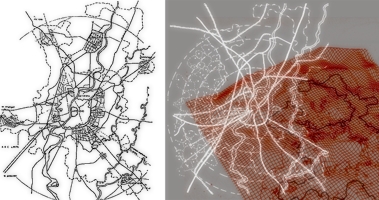A City-Machine Design Studio Cycle: Offered at Centre for Environmental Planning and Technology, Ahmedabad, 1999-2000 and TVB School of Habitat Studies, 2004-05.
— Anand Bhatt, Neelkanth Chhaya, BV Doshi and Mark Warner.
… having to do with domicile, or domestic and nomadic topologies
… having to do with real space, or surface boundaries
… having to do with the public,
and spaces of production, exchange and consumption.
The exercise was constructed as a single, loosely formed sequence of ideas, focusing on the complex, ‘organic’ multiplicities that constitute South Asian cities. We were focussed, on the one hand, on historical processes constantly informing the shaping of the city, and on the other, on the ‘moment’. The city was seen as a quasi-industrial system, which worked in order to re-produce itself and our design process borrowed ideas from the disciplines of production engineering and industrial engineering.
The city was seen as a mechanical assemblage, producing ever new formations within itself, constantly transforming and finding new identities. We thought in a single determinate mobilisation where we analysed Urban systems as constituted of various topologies, a consequence of force diagrammes which might be stated as: a City-Machine.
A city-Machine and its sub-systems were synthesized as 3D diagrammes and the diagrammes were treated as ‘sites’. Architecture in this instance inhabits a synthetic City-Machine rather than a space plotting divisions and classification, corporeally representing the ownership of property, or relations where a consumptive Immanence of the Eater and the Eaten is established.
The Phenomena under Study
Bataille once wrote of the cathedral of Reims, it’s beauty and its stability, its architecture until the war, and one day the shells arrived. The writing in a sense encapsulates the history of 20th century architecture, and the city: a city of processes at once formative and destructive, the processes of production, the production of production relations, and the production of destruction.
The Object under Study
The urban artefact is an objectile, a word to be placed in the same category as tactile, or projectile — a shell. Bound to and mobilised by its own trajectory and not much besides.
The twentieth-century town was a correlate of the road, it is said. The twentieth century saw a transformation in the way we understand the urban artefact, freed at last from the confines of physicality, of the surface. The urban artefact is seen outside of the empirically experienceable as our understanding of space and our own bodies transformed we now know space and our bodies with senses other then the bodily.
By its trajectories, the objectile forms a vast force field, a mathematical space, on the one hand, a space of diagrammes, of the ‘decomposition of bending moments or of flexions … where numerical division is only the condition of morphogenetic movements’ and on the other hand, the formation of an organism … ‘increasingly probable and natural when an infinity of intermediate states is given’.
Objective
To enter the diagramme composed, to enter the field and to inspect conditions possible by which the Urban Formation comes into becoming.
This design studio cycle sets out to learn to map, draw and compose the codes within which societies live, and cities come into existence. If the city is not understood as composed of “membranes and limits”, then the interior and exterior milieus come together as codings.
The agent of representation will need to compose and construct the appropriate membranes, but these will always need to arise from the processes of the milieux.

Footnotes
- Flexion/Abduction
- Shell: Only today, mutiliated, she rises in desolation.
- City/State: The town is the correlate of the road. The town exists only as a function of circulation and of circuits; it is a singular point on the circuits which create it and which it creates. It is defined by entries and exits: something must enter it and exit from it. It imposes a frequency. It effects a polarization of matter, inert, living or human; it causes the phylum, the flow, to pass through specific places, along horizontal lines. It is a phenomenon of transconsistency, a network, because it is fundamentally in contact with other towns. — Deleuze, Gilles; and Felix Guattari “City-State [from Plateau 13 of Mille plateaux]”, translated by Brian Massumi Zone 1-2 (1985): 194-217.
- Typological Instituted(s): By Typological Instituted(s) I mean things such as the inscriptions, marks of the state, the ‘internal’ regulatory principles that indicate the hieroglyph that persists at the core of architecture.

